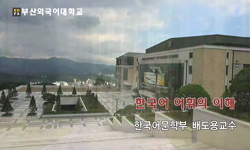파생어는 어기와 파생접사로 이루어지는 복합어이다. 어기는 하나의 단어일 때도 있고 의미상 그 단어의 중심 요소이지만 단어의 자격은 가지지 못한 어근일 때도 있다. 파생접사는 사전에 ...
http://chineseinput.net/에서 pinyin(병음)방식으로 중국어를 변환할 수 있습니다.
변환된 중국어를 복사하여 사용하시면 됩니다.
- 中文 을 입력하시려면 zhongwen을 입력하시고 space를누르시면됩니다.
- 北京 을 입력하시려면 beijing을 입력하시고 space를 누르시면 됩니다.
https://www.riss.kr/link?id=A100164783
- 저자
- 발행기관
- 학술지명
- 권호사항
-
발행연도
2012
-
작성언어
Korean
-
주제어
파생어 ; 파생접사 ; 표준국어대사전 ; 표제어 ; 뜻풀이 ; 접두사 ; 접미사 ; derivative ; derivational affix ; the standard of the Korean dictionary ; headword ; the explanation of meaning ; prefix ; suffix
-
KDC
001
-
자료형태
학술저널
-
수록면
323-354(32쪽)
- 제공처
- 소장기관
-
0
상세조회 -
0
다운로드
부가정보
국문 초록 (Abstract)
파생어는 어기와 파생접사로 이루어지는 복합어이다. 어기는 하나의 단어일 때도 있고 의미상 그 단어의 중심 요소이지만 단어의 자격은 가지지 못한 어근일 때도 있다. 파생접사는 사전에 독립 항목으로 등재되는 것이 일반적이다. 그러므로 사전의 기술에서 파생어와 어기와 접사는 서로 단어형성론적으로 밀접하게 관련되는 항목들을 구성하게 된다. 이에 따라 파생접사와 파생어의 기술은 단순어나 합성어의 기술에서와는 달리 복잡한 고려 사항들을 가지게 되며 그만큼 더 체계적인 기술 방안이 필요하게 된다. 본고에서는 국립국어연구원에서 편찬한『표준국어대사전』1)을 중심으로 파생어의 사전 처리에 대하여 살펴보면서 존재하는 문제점들을 제시하였다. 본고에서는 주로 파생어의 표제어 설정, 파생접사의 표제어 설정, 표제어의 표기, 파생접사의 뜻풀이, 파생어의 뜻풀이에 대해 살펴보았는데 파생어와 표제어의 설정 문제에 대해서는『표준국어대사전』에서 일관성을 반영하려고 노력했음을 볼 수 있는데 파생접사의 뜻풀이 가령 ‘-거리다/-대다’, ‘-답다’의 뜻풀이 등에 대한 사전 처리는 더 보완할 필요가 있으며 앞으로의 한국어사전편찬에 반영이 되었으면 한다.
다국어 초록 (Multilingual Abstract)
The derivative is a compound word which is made from the base and the derivational affix. The base sometimes can be a word, or just plays an important part of a word in the meaning as a stem. Generally, the derivational affix is registered as a indepe...
The derivative is a compound word which is made from the base and the derivational affix. The base sometimes can be a word, or just plays an important part of a word in the meaning as a stem. Generally, the derivational affix is registered as a independent item in the dictionary. So in the description of the dictionary, the derivative, the base, and the affix intimates with each other in the theory of the word's formation. For this reason, the description of the derivational affix and the derivative is different from the the description of the simple word and the compound word. So it needs to be a systematic way to describe of the derivational affix and the derivative when we do it in a complicated way. This paper aims to adduce some problem drawbacks when I examine the dictionary processing of the『the standard of the Korean dictionary』which is made in 1999. In this paper, I have examined the setting of the derivative's headword, the setting of the derivational affix's headword, the mark of the headword, the explanation of the derivational affix's meaning, and the explanation of the derivative meaning. we can find the consistency in the setting between the derivative and the headword, but the explanation of the derivational affix's meaning, just as the ‘-거리다/-대다’, ‘-답다’ is not enough. So I think it needs to be some more supplementation in this part.
목차 (Table of Contents)
- 1. 머리말
- 2. 파생어와 파생접사의 표제어
- 3. 파생접사와 파생어의 뜻풀이
- 4. 결론
- 1. 머리말
- 2. 파생어와 파생접사의 표제어
- 3. 파생접사와 파생어의 뜻풀이
- 4. 결론
동일학술지(권/호) 다른 논문
-
- 강남대학교 인문과학연구소
- 간호배
- 2012
-
백제 창왕명석조사리감(昌王銘石造舍利龕)명문(銘文)에 보이는 ‘태세(太歲)’의 의미
- 강남대학교 인문과학연구소
- 김선숙
- 2012
-
- 강남대학교 인문과학연구소
- 김경은
- 2012
-
- 강남대학교 인문과학연구소
- 박명숙
- 2012




 코리아스칼라
코리아스칼라







